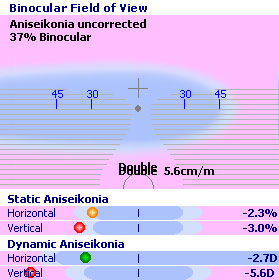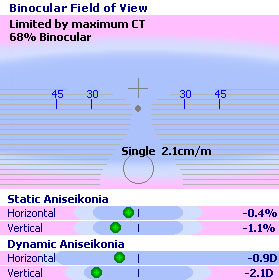Sudden onset due to monocular cataract surgery. Age 74.
| Sphere | Cylinder | Axis | Add | PD | |
| OD | +3.00 | -1.00 | 90 | 2.50 | 32 |
| OS | Plano | 2.50 | 32 |
| BU | BD | BI | BO | ||
| 3 | 3 | 4 | 8 |
| Eye | DBL | Wrap | Vertex | Height | |
| 52 | 15 | 6 | 12 | 18 |
Patients who experience spatial distortion and impaired depth perception as a result of the effects of dynamic aniseikonia due to sudden monocular prescription changes (caused, for example, by cataract surgery) can be prone to falls and injury. This is especially problematic for the elderly. Management of the dynamic components of aniseikonia is critical for these patients. Optometrists can provide expert management using the SHAW lens system.
This patient had cataract surgery performed on her left eye only. The cataract in the right eye was still marginal, and it was decided not to perform surgery until it became problematic. The patient wanted to retain the full-time use of progressive lenses. To maintain fusion in all positions of gaze and particularly in the progressive reading zone, the default dynamic design of the SHAW lens algorithm was selected. The patient picked up and wore the glasses without any problems. Binocular vision was maintained in distance and in near gazes. The SHAW lens design ensured that motor fusion limits were respected in all positions of gaze.
In order for rapid adaptation to occur following dramatic refractive error changes, both motor and sensory fusion stimuli need to be respected.



The area of binocular vision is almost twice as large as that of conventional lenses. In addition, both static and dynamic aniseikonia values fall well within the patient’s facility. This will result in significantly less distortion and dramatically improved depth perception.